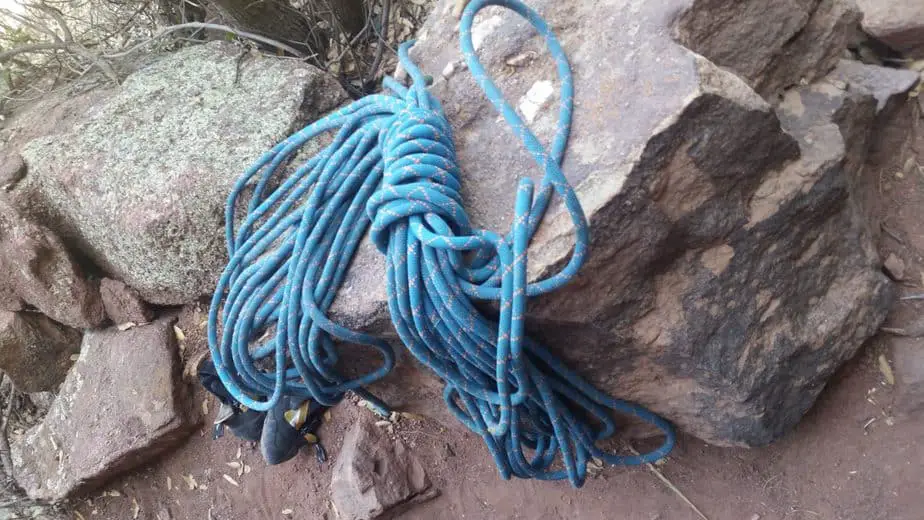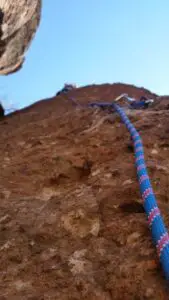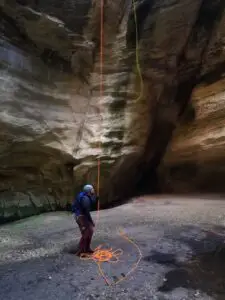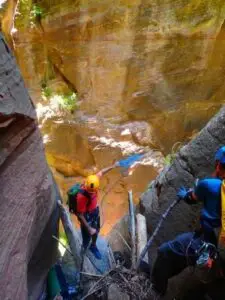Some canyons don’t require long ropes (though you should always have webbing and shorter lengths just in case), and you don’t need a rope to enjoy a good bouldering session. You can’t rappel without a rope, though you can without a harness.
The most expensive piece of equipment you need to buy is your rope. You can buy a lot of things second hand to save money, but a rope is not one of them. Generally, climbers and canyoneers start out buying cheaper things like harnesses, carabiners, and shoes. Once they’re sure they want to commit to these hobbies, they put down the investment required for a rope.
I remember buying my first rope right after finishing college. I had always lived close enough to my dad to just borrow his (I kept it at my place most of the time, to be honest), but moving across the country I knew that I needed my own. He surprised me with a climbing rope as a graduation present (which made college worth it).
A few months later I had planned a canyoneering trip to central Arizona, and laid down the investment for a static rappelling line. I’ll never forget the feeling I had when I first owned my own ropes. It was probably better than when I bought my first car!
Whether you’re contemplating buying your first rope or your fifth, check out our Rope Buying Guide for answers to all of your questions.
Best Dynamic (Climbing) Rope:
My favorite climbing rope is the 10.2 mm thick, 60 M long Beal Antidote. I really like how thick the rope feels in my hands. I tend to take a lot of new climbers out, and it is important for them to trust the weight of the rope in their hands before they lean back on it.
60 meters is a good length for your main climbing rope because most sport climbs in the US are between 30 and 60 meters. It comes with a black center mark, which has saved me multiple times! I’ve used it on a lot of days of multi-pitch climbing, and the weight of a thicker rope doesn’t cause any problems.
This is pretty inexpensive, as far as climbing ropes go. I don’t see any reason to pay more for ropes with the same features and safety ratings! One thing I especially like with this rope is the way it pops out in pictures with the bright blue color.
Located in France, and family-owned, Beal has a long and proud tradition of rope making. Their Unicore technology binds the core to the sheath, enhancing the safety of the rope in the case of a core shot.
Amazon: Beal Antitode Climbing Rope.
Best Static (Canyoneering/Rappelling) Rope:
I love this rope. We even went so far as to give it a name! The Edelweiss Canyon Rope (9.1 mm thick, 200ft) is lightweight (49 g/m), smooth, and strong as an ox. It’s especially good for long hauls and quick descents because of the weight. We named ours the “Twin Lasers” because of how the electric yellow color lights up rappels.
Edelweiss gives the rope their “Everdry” treatment, which keeps it from absorbing water in canyons. This makes a huge difference when going through wet sections, because your backpack doesn’t gain an extra 20 pounds! A thin rope like this makes for lightening-fast rappels.
It’s easy to pull through the anchors, and doesn’t kill your arms stuffing it in the bag afterwards. I’ve taken my rope through dirt, snow, sand, and sludge, and it still comes clean in the bathtub at home every time. The Edelweiss Canyon rope comes in at a very nice price point as well.
Amazon: Edelweiss Canyon Rope
Other Important Ropes and Webbing:
You need a few more shorter lines for climbing, rappelling, and canyoneering in case of emergencies. You should always have about 30ft of tubular webbing (designed for climbing) in order to build anchors or reduce rope drag. I keep a spool of Bluewater Tubular Webbing in my backpack. Be sure to carry a knife so you can cut it into the lengths that you need.
Amazon: Bluewater Tubular Webbing
I also keep a short length of 5mm rope for use as a Prusik. This is usually not rated for climbing, but can be used to ascend a rope in an emergency. This Bluewater 4mm Accessory Cord works well and is cheap.
works well and is cheap.
Amazon: Bluewater 4mm Accessory Cord
The last piece of rope required for some canyons is a pull cord. On a really long rappel, it’s a lot cheaper to buy an accessory cord to tie to your regular rope instead of doubling over your expensive static rope. You can get 100ft of 6mm accessory cord from Bluewater here.
Amazon: Bluewater Precut Accessory Cord
Rope Bags:
Sure, you look pretty cool with just a rope coiled and draped over your shoulders, but it’s really inconvenient. Also, a rope bag protects the rope and keeps it clean from grains of sand and cactus needles (not fun to pick out of a 200′ rope).
We list more information on our favorite rope bags in this article –
–
Keep an eye on your ropes and make sure they stay in good shape. The ends will take the brunt of the wear and tear, so consider trimming them as needed. Don’t take unnecessary risks, and have fun out there!




